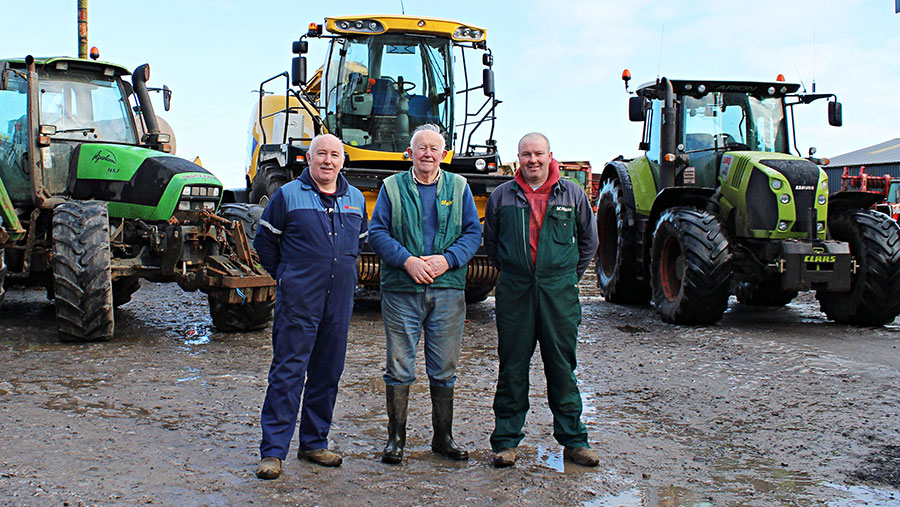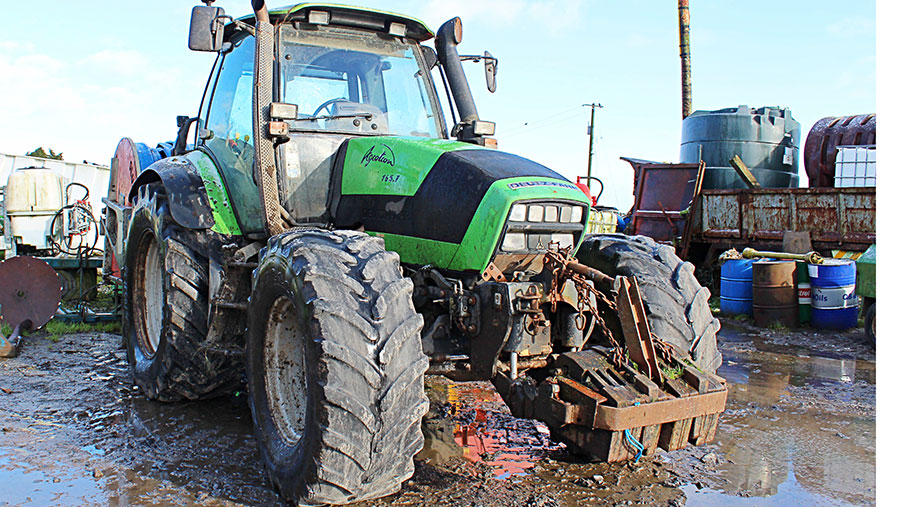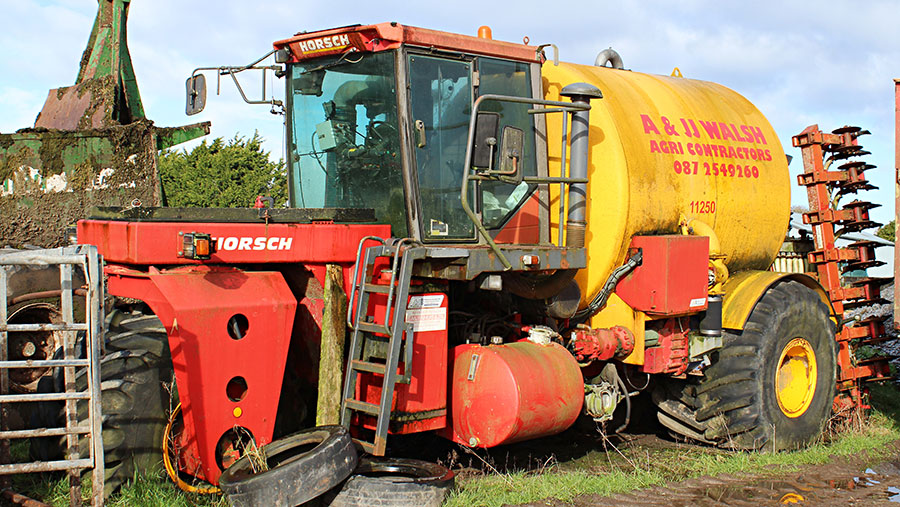What’s in Your Shed? visits an Irish grassland contractor
Our regular series looking at the best and worst of readers’ machinery sheds features County Mayo contractor A and JJ Walsh.
The family firm runs a fleet of Deutz-Fahr tractors and has a huge kit list to cope with the unreliable weather west of the Shannon River.
Work includes producing 18,000 silage bales and 730ha of clamp silage, as well as umbilical slurry spreading all year round.
Want to show us yours?
If you’d like us to feature your kit in our What’s in Your Shed? series, then drop us a line at oliver.mark@markallengroup.com
In the shed
- Tractors: Deutz-Fahr X720, 6210C, M620 and Agrotron 165; Claas Arion 640; John Deere 3050
- Forager: New Holland FR9060
- Balers: McHale Fusion x 2
- Mowers: McHale rear butterfly mowers; John Deere 131 front mowers x 3; John Deere 530 x 2 and 1365
- Tedder: Kverneland six-rotor
- Rake: Kverneland twin-rotor
- Loading shovel: Komatsu WA320
- Telehandler: JCB Loadall 526-56
- Slurry tankers: HiSpec 2,600gal with 7.2m dribble bar; Agromec 2,600gal x 2; Slurrykat 2,700gal with 9m dribble bar; Abbey 3000gal
- Trailers: Agromac 20ft x 2; Ruscon 18ft x 3; Herron 18ft
- Cultivation kit: Kverneland four-furrow ED 85 plough; Heva 6.3m disc harrow; Pottinger 3m power harrow with air seeder
How did you start out?
My dad started out contracting 60 years ago and at that time there was a sugar factory in the area, so a lot of his work revolved around beet.
This shut in the mid-1980s and, as a result, the grass area and the stock numbers gradually started to rise.
I came into the business about that time and we got into the silage business. I’ve been at it for about 30 years now.
See also: NAAC farm contractor charges 2017-18

John-Joe, Andy and Padraic Walsh © James Andrews
What are your biggest challenges?
The weather is our biggest challenge by far.
The Shannon River cuts through the centre of the country and it seems like anywhere to the west of it always gets unlucky with the weather.
Business facts: A and JJ Walsh, Turin
- Farmed area: 140ha of grass, some owned and some rented
- 65 head beef suckler herd and finishers
- Contracting: 730ha of clamp silage; 18,000 round silage bales; 1,500ha of mowing; slurry tanker and umbilical spreading all year round
- Staff: JJ plus three full-time and up to 10 in peak season
We’re firmly to the west and with 1,250mm of rain a year we have some very tight windows to work in.
For that reason we have to run a lot more kit than we should need for the area we cover.
The second challenge is the amount of competition in the area.
There are lots of young lads starting out, which drives prices down and makes it hard to stay competitive.
What made you choose a New Holland forager?
Over the years we’ve had several different forager brands and the new Hollands have been some of the most reliable. So when we came to upgrade, we decided to stick with what we knew.
Our first self-propelled was a New Holland 1900s that we had for three years. It was slow, but didn’t give us much trouble.
We replaced it with a John Deere 6810, which was also fairly good, before switching to a Case/Mengele 7400 in 2000.
That was the most troublesome machine we’ve had. It came with a series of problems with the blower and electrical system.
After that we went back to New Holland and got an FX50 – it was so good we kept it for 12 years.
When we came to replace it, we tried out a Krone Big X 580, which I was very impressed with, but in the end we thought the New Holland had the edge.
How brand loyal are you?
On the tractor front we’ve been mainly Deutz since about 2004 when a local dealer picked up the franchise.
Another local contractor bought one before me and he seemed pretty impressed, so we decided to give one a try too. Our first was an Agrotron 130 and we liked them so much we got another three over the next two years.
Sadly, the dealer lost the franchise in 2012, so we had to go a bit further afield to get them. That meant our largest X720 came from Yorkshire and our 6210 came from Jacobs of Enniscrone up on the north coast.
However, a local dealer John Murphy has recently taken it on, so the next one will probably come from there.
Favourite dealer?
McHale Machinery at Kilmaine – it’s local, has a wide range of kit and offers a good service. John Murphy (Murphy Agri Machinery) at Horsevalley is also very accommodating with flexible opening hours and always on call to help you out.
Favourite piece of kit?
The New Holland FR9060 forager is my favourite. It’s got a much smoother grass flow than the old FX50, a lot more power and it seems to use that power much more efficiently too.
Least favourite?
I really don’t like our HiSpec tanker. There’s something wrong with the geometry, meaning it’s heavy to pull and always feels like it’s fighting against you – it’s almost like the brakes are on.
Also, even though it’s on big 800/65R32 tyres, it sinks into wet ground much more than our other tankers of a similar size.
As an aside, we’ve also had a few problems with the macerators on our machines with dribble bars. The problem is that they’re sold as macerators, but they are actually distributors.
This means they’re not up to the job of dealing with slurry containing solids.
Latest purchase?
We’ve just invested in a Mastek umbilical slurry system so we can get on the ground when it’s too wet for the tankers to travel.
It’s all a bit new to us at the moment, but we’ve been pretty impressed with it so far. In fact, we might extend the system next year so we can cover a bit more ground.
Oldest machine still at work?
We’ve got a John Deere 3050 that spends its days on a Trioliet tub feeder. We only bought it last year though, as we needed a spare yard tractor and didn’t want to spend too much.
We’ve also got a 1996 JCB Fastrac 1115 that we’ve had since 2001. It has spent most of its time pulling a 6t Ruscon trailed spreader and gave us very little trouble. It’s semi-retired now though.

Deutz-Fahr Agrotron 165 © James-Andrews
How long do you keep your machines?
We tend to change tractors every five to six years, but because our work has been getting squeezed into shorter and shorter windows, we’ve kept a few on longer and the numbers have gradually crept up.
We don’t tend to buy extended warranties, apart from when we bought our Claas Arion. As that was a new machine to us, we thought we’d cover our backs a bit. Other machinery is changed as and when.
Do you buy second-hand?
We buy a few second-hand machines. Our biggest Deutz X720 was one of the most recent second-hand purchases, as we couldn’t really justify buying a tractor of that size new.
What’s next on your wish list?
We’re considering getting a McHale Fusion 3 Plus baler/wrapper to replace our Fusion 2. We’ve had a few people request film instead of net wrap, so it might be worth spending the extra cash so we can offer it.
The Komatsu loading shovel could also do with upgrading. I’d quite like to buy the same again, but I’m looking at a New Holland as well.
Biggest machinery mistake?
In 2013 we imported a used Horsch Trike from the Netherlands. The idea was that its low ground pressure would allow us to travel on wetter ground and speed up our slurry-spreading operation.
It was a bit of a disaster. Firstly, the land we work is fairly fragmented, meaning a lot of time is spend on the road.
The Horsch was clumsy and slow on tarmac, meaning it could only do jobs closer to home. It’s also pretty hopeless on sloping ground, which we have more than our fair share of here.
After battling with it for three years, we parked it up and it’s been in the yard ever since. I haven’t had much luck selling it either. With hindsight I should have spent a bit more and bought a Vervaet.

Horsch Trike © James Andrews
Most expensive repair bill?
I can’t think of any real horror stories, but we did spend a lot keeping our Case forager running.
On one occasion it took three days for the dealer to pin down an electrical fault that disabled all the hydraulic services on the machine. It turned out to be a corroded connector on a light behind the dash.
What’s your best invention?
We’re not big inventors, but we spend a lot of time maintaining our equipment. As the old saying goes, “you get out what you put in”, and because it’s all kept up together we don’t get too many breakdowns.
What’s your everyday transport?
I’ve recently got a new 2017 Isuzu D-Max to replace my 2010 model. I didn’t want one of the 1.9-litre models, so luckily I managed to get one of the last three 2.5-litre models in Ireland.
It’s a big improvement on the older model and seems to have more legroom. Hopefully they’ll have started fitting bigger engines again when I next come to change.
Best tractor?
We’ve got a 2008 Deutz Agrotron 08 Profiline that’s been fantastic. It’s on 11,000 hours, has been very reliable and we remapped it to 180hp, so it goes really well too. It’s a real pleasure to drive.
We had it new and it’s done a mix of jobs, including mowing, ploughing and trailer work. This winter it’s been busy pulling the umbilical pipe.
It’s on 650 tyres at the moment, but I might get some bigger ones to help it stay afloat a bit better.
All we’ve done to it is routine servicing and fitted a new exhaust. The only downside is the air conditioning, which is poor in all our Deutz tractors.
Worst tractor?
We had a 1993 New Holland 7840 that had no end of engine problems. We really needed an 8340, but the dealer persuaded us to go for the smaller tractor with a retrofit turbo.
Three engines later we ended up getting an 8340, which performed well.
Any machinery bargains?
Our Deutz tractors have been some of our better-value investments. We got a great deal on the first few and they’ve given us very good service.

